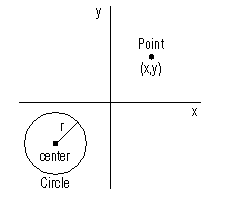Tutorial exercise 4: Creating opaque data types
This exercise demonstrates how to create opaque data types, their support routines, and user-defined routines that operate on them. This exercise has 11 steps. It takes approximately one hour to complete.
About this task
The example Circle DataBlade® module in this exercise is similar to the RowCircle DataBlade module in the Creating Row Data Types exercise. The difference is that the Circle DataBlade module creates opaque data types, whereas the RowCircle DataBlade module creates row data types.
- Store circles or points in a single column of a database table.
- Calculate the distance between two points.
- Calculate whether a circle contains a point.

The Circle DataBlade module that you create in this exercise is similar to the example Circle DataBlade module included with the DataBlade Developers Kit. You can look at the example DataBlade module to see how to change the input format of an opaque circle type and how to add functionality. The example Circle DataBlade module is located in the %INFORMIXDIR%\dbdk\examples\types\dapi\Circle directory, where %INFORMIXDIR% is the environment variable that represents the root directory of your DBDK installation.